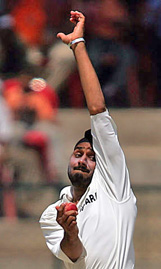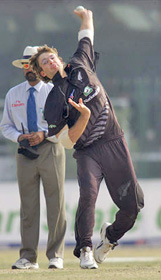COACHING
The art of Spin Bowling - I
- By SP. Bhatia The bowlers, they say, win matches, while the batsmen save them. To win a cricket match, it is important to be able to take wickets at regular intervals and keep the opposition under pressure. There are two types of bowlers that one gets to see in cricket' The fast bowlers tend to be more physical in their approach, their aim being to propel the ball towards the batsman as fast as they can. Spinners on the other hand, are more cerebral. They are expected to compensate for their lack of speed by using their brains, fingers and wrists to outwit their opponents.Let's take a look at the varieties of spin bowling.
Off-spin bowling has been dominated in modern times by Muttiah Muralitharan, currently the second-highest wicket-taker in Test cricket. Lance Gibbs, the West Indian off-spinner of the 60s and 70s, was the first spin bowler to take 300 Test wickets. India's very own Harbhajan Singh is an off-spin bowler who seems destined to attain greatness.
OFF SPIN

THE OFF-BREAK:
An off-break is a delivery that changes direction from the off-stump to the leg-stump after pitching. It is usually bowled at a slower speed. Off-spin bowlers do not achieve as much bounce as their leg-spinning counterparts, but they usually have good control over the ball. It is necessary that they pitch the ball at the perfect length to prevent the batsmen from scoring.
The grip for an off-break:
1. Hold the ball with the seam in a vertical position. Spread the first and second fingers across the top of the ball on the seam, using your third finger and thumb to support the ball. Use your first finger to spin the ball. Keep your hips and shoulders in line as you land on your right foot. Lean back, maintain the side-on position and look over your left shoulder. Make sure your right foot is parallel to the crease.
2. As you prepare to deliver the ball, start uncoiling your body. Shift the body weight gradually from the back leg to the front leg. Cock your wrist backwards, continue to look at your target over your left shoulder, use the left arm to maintain balance as your right arm comes over.
3. As you release the ball, spin it sharply by moving your first finger downwards and thumb upwards. Make your bowling arm brush past your right ear as it moves downwards. Your body will gain momentum as it uncoils and your weight shifts onto the ball of your left foot. Keep your hand upright throughout the bowling action, drive your back knee forward, and keep your weight on the ball of the front foot.
4. Swivel your upper body on the left knee as you complete the follow through. Your bowling arm should complete its action near the right hip. Your head should remain upright and steady. Your body should have turned 180° from the pre-delivery position. The body weight should be transferred onto your toes as you follow through.

THE OFF-SPINNER'S ARM BALL:
The arm ball is one of the variations that should be part of every off-spin bowler's armoury.
To bowl the arm ball, the smooth side of the ball should be gripped instead of the seam, as is done while bowling the off-break. The grip should not very tight. The bowler should drag the ball with his shoulder action towards first slip, as he rotates on the front foot. Rather than spin the ball, he should slide the fingers of his bowling hand around its right hand side, keeping the seam pointing towards the first slip. The ball should be pitched either on middle or off-stump, so that it drifts away to bounce outside the off-stump.
THE OFF-SPINNER'S TOP SPINNER:
Another variation that prevents the off-spin bowler from becoming predictable.
The run-up for bowling the top-spinner is the same as that for bowling the off-break. The grip also remains the same, except that the second finger is bent, so that the ball lies between the first finger and the knuckles of the second finger. The bowling palm should face the head. The ball should be released before the arm reaches the highest point of the swing, so that the ball travels initially in an upward direction towards the batsman. The swing of the arm should be close to the opposite side of the body.
LEFT ARM SPIN

India,
widely known as the Land of Spin, has produced two
of the greatest exponents of this art, in Vinoo
Mankad and Bishan Singh Bedi. Other notable
left-arm spinners to have graced the game are the
Englishmen Wilfred Rhodes, Hedley Verity and Derek
Underwood. Daniel Vettori (New Zealand) and Ashley
Giles (England) are keeping this form alive today.
An orthodox left-arm spin bowler turns the ball from the right-hander's leg-stump to the off-stump. Like off-spin, it involves the use of the fingers. The major difference between off-spin and left-arm spin is that the ball turns in the opposite direction.
STOCK DELIVERY:
The left-arm spinner's stock delivery changes direction from the leg-stump to the off-stump after pitching.
An orthodox left-arm spin bowler turns the ball from the right-hander's leg-stump to the off-stump. Like off-spin, it involves the use of the fingers. The major difference between off-spin and left-arm spin is that the ball turns in the opposite direction.
STOCK DELIVERY:
The left-arm spinner's stock delivery changes direction from the leg-stump to the off-stump after pitching.
The grip for the left-arm spinner's stock ball is the same as that adopted by a right-arm off-spinner to bowl the off-break, as mentioned above. The difference is that the opposite hands and legs come into play.

The
left-arm spinner has to flight the ball more in
order to vary his line and length, which will
enable him to deceive the batsman.
THE ARM BALL:
The left-arm spinner's arm-ball can be a lethal weapon. It can fetch him lots of wickets if mastered. The left-arm spinner's arm ball turns from the off-stump to the leg-stump. It pitches just outside or on the off stump, and then drifts into the middle or leg stump.
LEFT-ARM SPINNER'S TOP-SPINNER:
The grip is the same as that used by a right-arm off-spinner to bowl his top-spinner. The opposite hand should be used.
THE ARM BALL:
The left-arm spinner's arm-ball can be a lethal weapon. It can fetch him lots of wickets if mastered. The left-arm spinner's arm ball turns from the off-stump to the leg-stump. It pitches just outside or on the off stump, and then drifts into the middle or leg stump.
LEFT-ARM SPINNER'S TOP-SPINNER:
The grip is the same as that used by a right-arm off-spinner to bowl his top-spinner. The opposite hand should be used.